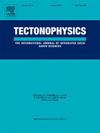Mantle upwelling induced by a bilateral convergent double subduction during Late Paleozoic in Eastern Tianshan, NW China: Evidence from high-resolution magnetotelluric profile
IF 2.6
3区 地球科学
Q2 GEOCHEMISTRY & GEOPHYSICS
引用次数: 0
Abstract
Late Paleozoic oceanic subduction has been proposed for the formation of Eastern Tianshan, NW China, situated in the southern Central Asian Orogenic Belt. However, the patterns and consequences of the subduction remain undetermined. To identify the mode of the Late Paleozoic subduction, a high-resolution magnetotelluric (MT) long-profile across Eastern Tianshan was deployed. A three-dimensional (3D) inversion was conducted to obtain the resistivity model beneath the profile. The most obvious feature in the resistivity model is a well-developed conductor (∼30 Ωm) beneath Turpan-Hami Basin from ∼15 km depth extending to the uppermost mantle. This conductor is preferably ascribed to the metamorphic fluids from an ancient mantle upwelling. In addition, the MT observation suggests a double subduction in the south Kangguer suture, together with a southward dipping subduction in the north Kalamaili Fault during the Late Paleozoic. The bilateral convergent double subduction induced the mantle upwelling and controlled the initial extensional environment during Late Paleozoic in the Turpan-Hami Basin.
东天山晚古生代双俯冲诱导的地幔上涌:高分辨率大地电磁剖面证据
位于中亚造山带南部的东天山,被认为是晚古生代洋俯冲形成的。然而,俯冲的模式和后果仍未确定。为了确定晚古生代东天山的俯冲模式,利用高分辨率大地电磁长剖面对东天山进行了研究。进行了三维反演,得到了剖面下的电阻率模型。在电阻率模型中,最明显的特征是吐哈盆地下方有一条发育良好的导体(~ 30 Ωm),深度为~ 15 km,一直延伸到最上层地幔。这种导体最好归因于来自古地幔上升流的变质流体。此外,MT观测表明晚古生代康格尔断裂带南部存在双俯冲,卡拉麦里断裂带北部存在南倾俯冲。吐哈盆地晚古生代两侧辐合双俯冲诱导地幔上涌,控制了初始伸展环境。
本文章由计算机程序翻译,如有差异,请以英文原文为准。
求助全文
约1分钟内获得全文
求助全文
来源期刊

Tectonophysics
地学-地球化学与地球物理
CiteScore
4.90
自引率
6.90%
发文量
300
审稿时长
6 months
期刊介绍:
The prime focus of Tectonophysics will be high-impact original research and reviews in the fields of kinematics, structure, composition, and dynamics of the solid arth at all scales. Tectonophysics particularly encourages submission of papers based on the integration of a multitude of geophysical, geological, geochemical, geodynamic, and geotectonic methods
 求助内容:
求助内容: 应助结果提醒方式:
应助结果提醒方式:


